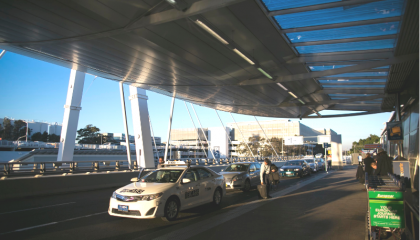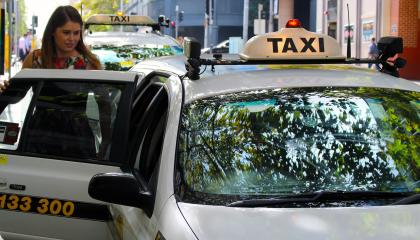What responsibilities, or obligations, do I have as a taxi licence holder?
The law requires the following of those who hold a taxi licence (operate a taxi service).
Abide by safety standards
The Regulation sets out the safety obligations of a taxi licence holder. There are two levels of safety obligation, or responsibility:
- for some safety standards, the taxi licence holder is identified as a ‘specified person’, in which case they must not violate the safety standard
- for other safety standards, the taxi licence holder is identified as a ‘responsible person’, in which case they must ensure, so far as is reasonably practicable, that the safety standard is complied with.
For each of the safety obligations below, the level of responsibility has been shown.
For more information, please refer to the Safety standards for taxis webpage.
Only use a registered and roadworthy vehicle
The vehicle used to provide a taxi service must be appropriately registered and safe to be driven on the road (roadworthy). It must undergo annual safety checks — previously called a ‘pink slip’ — even if it is less than five years old.
For this safety standard, the taxi licence holder is a responsible person.
For more information, please refer to the Safety standards for taxis webpage.
Make sure the vehicle is regularly and properly maintained
A vehicle used to provide a taxi service must be regularly and properly maintained by a qualified mechanic, consistent with the recommendations of the vehicle manufacturer and records providing evidence of this maintenance must be readily available.
For this safety standard, the taxi licence holder is a responsible person.
For more information, please refer to the Vehicle maintenance and safety inspections checklist.
Make sure the vehicle has enough seating and doors
A taxi must have seating accommodation for the driver and for at least four and not more than 11 other adult persons. It must have at least four side doors except if it is a wheelchair accessible taxi or sits more than six people.
For this safety standard, the taxi licence holder is a specified person.
For more information, please refer to the Safety standards for taxis webpage.
Make sure the vehicle has taxi plates issued by Service NSW
The application process for a taxi licence includes a step in which the applicant will either select a Service NSW branch from where they will pick up their new taxi plates or validate existing taxi plates which will then be associated with the new taxi licence. The taxi plates must be securely attached to the vehicle providing taxi services.
For this safety standard, the taxi licence holder is a responsible person.
For information on how to manage taxi number plates, please refer to the Taxi Plate Management webpage.
Make sure the vehicle is fitted with proper signs, lights and markings
- Signs: A taxi must be fitted with a roof sign that displays the word “TAXI”, “CAB” or “CABS” in black lettering at least 70 mm high. These words can be in upper or lower-case letters, or a combination of upper and lower-case letters.
- Lights: A taxi must be fitted with a roof light that is clearly visible in daylight from a distance of 40 metres by a person with normal eyesight. The roof light must be lit when the taxi is available for hire but must not be lit at any other time.
- Markings (or livery): A taxi must be painted or marked so that it is clearly identifiable as a taxi. The provider of the taxi service must paint or mark the taxi so that the following details are displayed prominently and are clearly visible on the taxi – the provider’s name or logo or colours and contact information.
- Taxi Fare Hotline stickers: A minimum of two Taxi Fare Hotline stickers must be displayed – at least one on the outside of the vehicle and one inside the vehicle. The stickers must be clearly visible to all passengers in the taxi, and to prospective passengers. Displaying the stickers on the back quarter panel window inside the taxi and in the same location on the outside of the taxi - ideally on both sides of the vehicle – is recommended. The positioning of the stickers should not affect a driver’s visibility – safety is always the priority.
For this safety standard, the taxi licence holder is a responsible person.
For more information, please refer to the Safety standards for taxis webpage.
Make sure the vehicle is fitted with a compliant fare calculation device (‘meter’)
Taxis must have a functioning fare calculation device (‘meter’) which is resistant to tampering and vandalism, securely fixed in a commercially designed and manufactured mount, in safe position and which can display and charge the authorised fare depending on taxi location.
For this safety standard, the taxi licence holder is a specified person.
For more information, please refer to the Fare Calculation Devices.
Make sure the vehicle is fitted with a compliant security camera system
Taxis must have an approved security camera system that is in working order, and for which there are obvious signs inside and outside the taxi advising that persons may be under surveillance.
For this safety standard, the taxi licence holder is a specified person.
For more information, please refer to the Security Camera Systems webpage.
Make sure the vehicle is fitted with a compliant duress alarm system
Taxis used to provide services in the Sydney Metropolitan, Newcastle or Wollongong transport district or within the Central Coast local government area, must have a working and compliant (per TfNSW specifications) duress alarm system.
For this safety standard, the taxi licence holder is a specified person.
For more information, please refer to the Safety standards for taxis webpage.
Make sure the vehicle is fitted with a compliant vehicle tracking device
Taxis used to provide services in the Metropolitan, Newcastle or Wollongong transport district or within the Central Coast local government area, must have a working and approved vehicle tracking device.
For this safety standard, the taxi licence holder is a specified person.
For more information, please refer to the Safety standards for taxis webpage.
Make sure specified information is displayed inside the taxi
A taxi must display the following information inside the vehicle and it must be in clear view of passengers:
- The vehicle registration number of the taxi.
- Contact information (telephone number and/or website) for the person or business authorised to provide the taxi service – the taxi service provider.
- Fares and other charges: The authorised fares for journeys and any additional tolls, fees or charges, that may be payable.
- Security camera notice: A notice advising passengers that they may be under video surveillance while in or about the taxi.
- Taxi Fare Hotline stickers: At least one Taxi Fare Hotline sticker must be displayed on the back quarter panel inside the taxi and in the same location on the outside of the taxi - ideally on both sides of the vehicle.
- Driver ID: The ID (digital or physical card) must include a photo of the driver and an ID number that has been provided by the taxi service provider. It must be displayed in an ID card holder.
For this safety standard, the taxi licence holder is a specified person.
Make sure each vehicle has $5 million of third-party property insurance
A vehicle used to provide a taxi service must have third-party property insurance which provides cover of at least $5 million.
For this safety standard, the taxi licence holder is a responsible person.
For more information, please refer to the Vehicle Insurance fact sheet.

